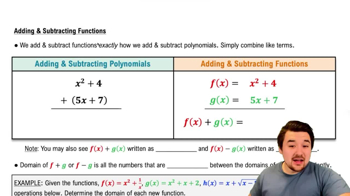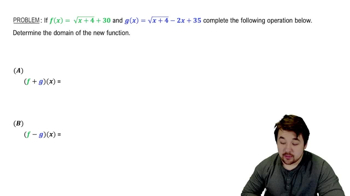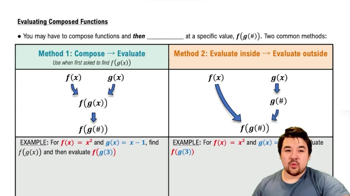Table of contents
- 0. Functions7h 52m
- Introduction to Functions16m
- Piecewise Functions10m
- Properties of Functions9m
- Common Functions1h 8m
- Transformations5m
- Combining Functions27m
- Exponent rules32m
- Exponential Functions28m
- Logarithmic Functions24m
- Properties of Logarithms34m
- Exponential & Logarithmic Equations35m
- Introduction to Trigonometric Functions38m
- Graphs of Trigonometric Functions44m
- Trigonometric Identities47m
- Inverse Trigonometric Functions48m
- 1. Limits and Continuity2h 2m
- 2. Intro to Derivatives1h 33m
- 3. Techniques of Differentiation3h 18m
- 4. Applications of Derivatives2h 38m
- 5. Graphical Applications of Derivatives6h 2m
- 6. Derivatives of Inverse, Exponential, & Logarithmic Functions2h 37m
- 7. Antiderivatives & Indefinite Integrals1h 26m
- 8. Definite Integrals4h 44m
- 9. Graphical Applications of Integrals2h 27m
- 10. Physics Applications of Integrals 2h 22m
0. Functions
Combining Functions
Problem 41b
Textbook Question
In Exercises 41 and 42, (a) write formulas for ƒ ○ g and g ○ ƒ and find the (b) domain and (c) range of each.
ƒ(x) = 2 - x², g(x) = √ x + 2
 Verified step by step guidance
Verified step by step guidance1
To find the composition of functions ƒ ○ g, substitute g(x) into ƒ(x). This means replacing every instance of x in ƒ(x) with g(x). So, ƒ ○ g(x) = ƒ(g(x)) = 2 - (√(x + 2))².
Simplify the expression for ƒ ○ g(x). Since (√(x + 2))² simplifies to x + 2, the expression becomes ƒ ○ g(x) = 2 - (x + 2).
To find the composition of functions g ○ ƒ, substitute ƒ(x) into g(x). This means replacing every instance of x in g(x) with ƒ(x). So, g ○ ƒ(x) = g(ƒ(x)) = √(2 - x² + 2).
Determine the domain of ƒ ○ g. The domain of g(x) is x ≥ -2, and for ƒ ○ g(x) to be defined, the expression inside the square root must be non-negative. Therefore, solve x + 2 ≥ 0 to find the domain of ƒ ○ g.
Determine the range of ƒ ○ g. Since ƒ ○ g(x) = 2 - (x + 2), analyze the behavior of this linear function over its domain to find the range. Similarly, analyze the domain and range of g ○ ƒ by considering the restrictions imposed by the square root and the quadratic expression.
 Verified video answer for a similar problem:
Verified video answer for a similar problem:This video solution was recommended by our tutors as helpful for the problem above
Video duration:
5mPlay a video:
Was this helpful?
Key Concepts
Here are the essential concepts you must grasp in order to answer the question correctly.
Function Composition
Function composition involves combining two functions, where the output of one function becomes the input of another. For functions f and g, the composition f ○ g means applying g first and then f to the result. Understanding how to correctly apply this process is essential for solving the problem.
Recommended video:

Evaluate Composite Functions - Special Cases
Domain and Range
The domain of a function is the set of all possible input values (x-values) that the function can accept, while the range is the set of all possible output values (y-values) that the function can produce. When composing functions, it is crucial to determine the domain and range of both the individual functions and the composed functions to ensure valid inputs and outputs.
Recommended video:
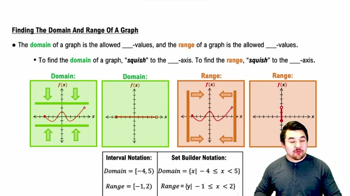
Finding the Domain and Range of a Graph
Square Root Function
The square root function, denoted as g(x) = √(x + 2), is defined only for non-negative values of its argument. This means that the expression inside the square root must be greater than or equal to zero. Understanding the restrictions imposed by the square root function is vital for determining the domain of the composed functions.
Recommended video:
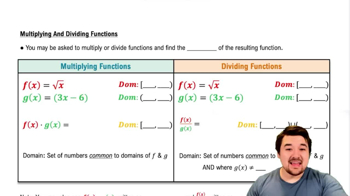
Multiplying & Dividing Functions

 5:56m
5:56mWatch next
Master Adding & Subtracting Functions with a bite sized video explanation from Nick
Start learning
